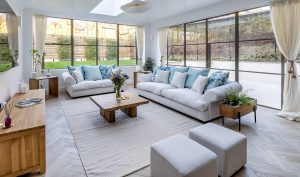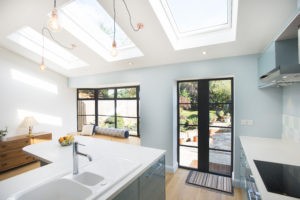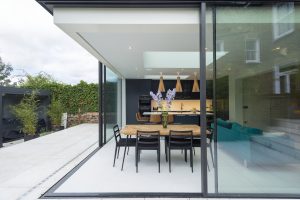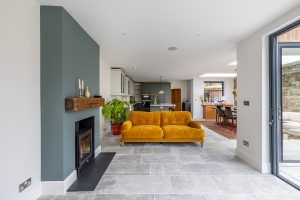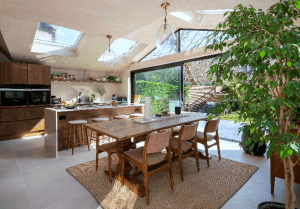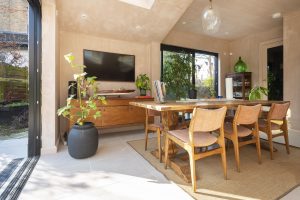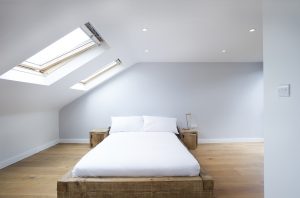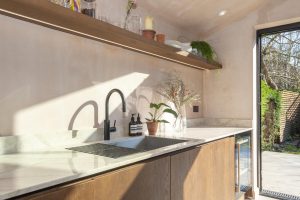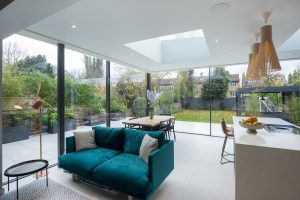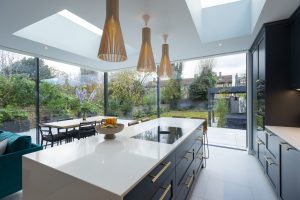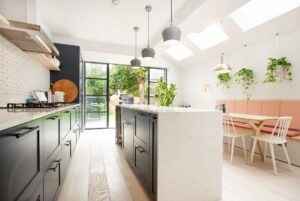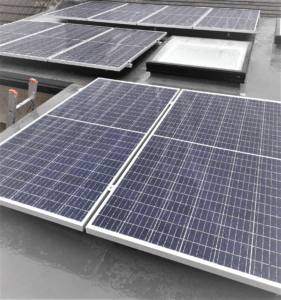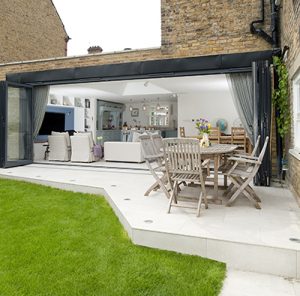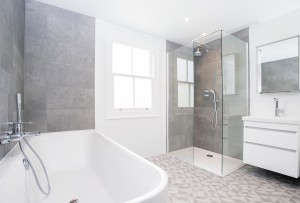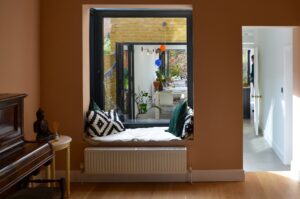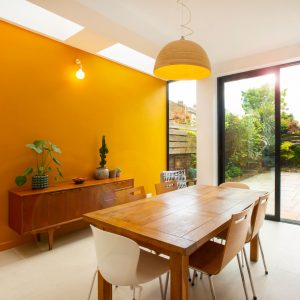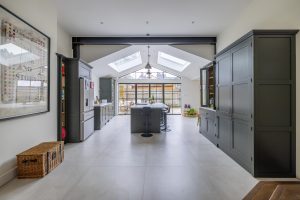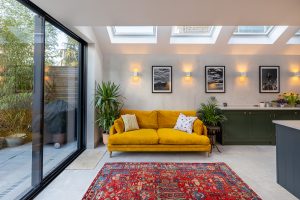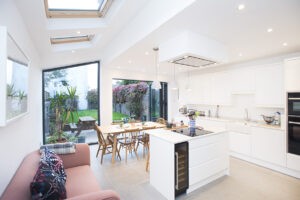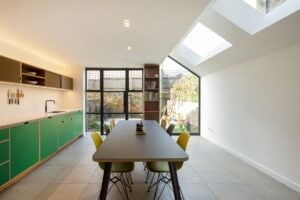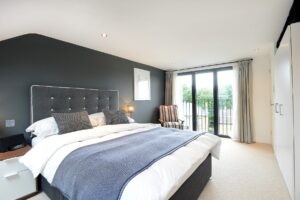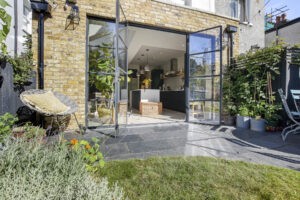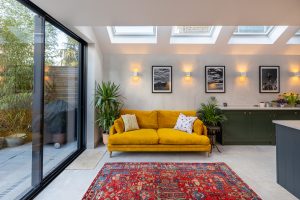Incorporating plenty of glass in a new extension is an increasingly popular trend with house owners. The extension not only looks stunning, it combines comfort, style and connects the extension seamlessly with the garden outside. A modern house extension with plenty of glass is filled with natural daylight. This is known to positively impact mood and enhance the sense of well-being. The Royal Institute of British Architects states that glass extensions can increase the value of a property by as much as 20%. Many families are finding that their beautiful new extension has increased functionality and has become a light, bright, family hub.
The designs for glass extensions are very flexible. Modern frameless glass extensions, have sleek styling, or you can choose a more traditional design such as an orangery. Glass can be used in the extension different ways including large windows and glass doors. Some designs feature entire glass walls or roofs. Glass complements natural wood and stone well. Light-coloured paintwork and carefully chosen ambient lighting can create the perfect ambiance. Glass extensions offering easy access into the garden are perfect for al fresco brunches and barbecues.
Types of Glass for Home Extensions
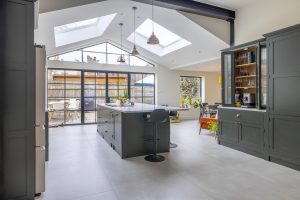
There is a variety of different types of glass that can be used for home extensions. It is a good idea to understand the differences and the benefits of each kind. Discuss your ideas about energy-efficient glass with your chosen building company.
1. Double-glazed V triple glazed glass
Double glazing uses two layers of glass with a gap between them. The gap is filled with air or an insulating gas. This type of glass provides good insulation against sound and heat and helps to reduce heating bills. It is more affordable than triple-glazed glass and is suitable for use in most climates.
Triple-glazing is constructed in the same way, but uses three sheets of glass, with two air or gas-filled layers in between. This offers better sound and heat insulation, making it more energy efficient. Triple-glazing is more expensive because of the extra materials used in its construction. Making triple-glazing also involves a more complex manufacturing process. This type of glass is particularly suitable for colder climates or where noise reduction is a top priority.
2. Low-E glass-extension
Low-E or low-emissivity glass has a special coating that allows light to pass through it, but reflects infrared heat. This helps to minimise heat lose, because the heat in the extension is reflected back into the space,. This helps to create a more comfortable environment. Low-E glass also keeps the extension cooler in hot months, so heating and cooling costs are reduced.
3. Smart / dynamic glass
Smart or dynamic glass is a type of glass that alters its transparency or tinting in response to the weather. This makes it more energy-efficient and the extension will stay at a more comfortable temperature. There are several different types of smart glass on the market including electro-chrome glass, photochromic glass. All of these types of glass react to sunlight – getting more tinted as temperatures rise.
4. Tinted V clear glass
Tinted glass is lightly coloured by the addition metal oxides (or similar) during the manufacturing process. The tint can vary in intensity from very pale to dark. Tinted glass makes it harder for people outside to look into the extension. This is a good way to gain privacy without the need for curtains or blinds. Tinted glass also reduces the amount of UV radiation, keeping the room cooler and also protecting furniture from fading. If the tinted glass is too dark though, it will reduce the natural light entering the room.
Clear glass is not tinted in any way. It offers maximum natural light and visibility. Aesthetically, there is a superb view of the outdoors including gardens and attractive views. The main drawback is a build -up of heat in the summer. This proves a great risk of faded furniture and textiles. Clear glass does not offer privacy, but this can be provided by well-placed shrubs outside the extension.
Advantages of Using Glass for Your Extension
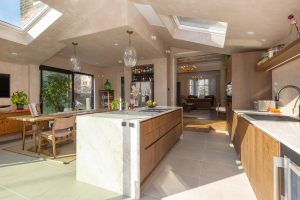
There are many advantages to having a glass extension – especially one featuring insulated glass panels. Glass extensions offer great natural light which is great to work in and negates the need for daytime artificial light. A light airy room also has a positive ‘feel good’ factor. Glass extensions make nature feel part of the home and this creates the perfect relaxing environment. Glass extensions are both modern and stylish in appearance. They can provide extra kitchen space, a dining area or home office. They can also provide the perfect spot to relax with a coffee.
A glass extension not only brings the outdoors inside, it gives easy access to the garden / terrace to maximise their use too. There are three main designs of glass doors to choose from – bi-folding, sliding and critall doors. One of these styles, will suit your family’s individual needs perfectly.
Gain valuable extra space for your family with a quality glass extension. A bonus is that it is a great investment in your home as it will add value to your property.
Energy Efficiency and Insulation Considerations
Conventionally, glass conservatories were traditionally built with glass walls and roof. It was very much an ‘add-on’ to the main house. It was only comfortable during certain months, as it lacked insulation and would be either too cold or too hot. In sharp contrast, modern glass extensions are structurally strong. They they usually have solid walls with energy-efficient glazing. The glass is crafted into large panes to be used as windows and doors. Modern glass extensions create valuable additional space for year round use.
Clearly, there are several points to consider when planning your new extension. The first is the orientation of the extension as a south-facing extension could get too hot in the summer months. It is important to choose high-performance glass that will help with thermal efficiency. The use of Smart glass and coated glass will help to keep the extension at a comfortable temperature. Consider investing in quality floors and walls too. This will enhance the thermal efficiency of the extension and minimise the use of supplementary heating and cooling systems. Use blinds and awnings for better temperature control in extensions.
Planning Permission and Regulations
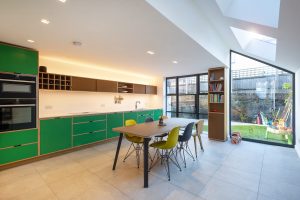
You may well need planning permission for a glass extension – depending on the location of your property and the planned size. There are often local regulations to consider too. Sometimes, smaller extensions fall under permitted development rights. It is essential when you are at the planning stage to check with your local planning authority.
A top consideration must be fire safety. There are a number of building codes that the glass extension must comply with. These include the use of fire-resistant glass, fire-exits and firebreaks. These help contain a fire so that it does not spread to the main house. Your architect will ensure that your proposed glass extension meets all the necessary building and safety requirements. They will ensure that the floor plan and building materials comply with all regulations. Likewise, the architect will help to obtain the required building permission.
Cost and Maintenance
The average cost of glass extensions varies between £1,500 – £3,000 per square metre. The factors determining the price will be the size, the complexity of your chosen design and the building materials used. The construction will take 2-5 months, depending on the same factors. As well as building materials and labour, the cost additionally includes the work of an architect, designer and structural engineer.
To increase the durability of your glass extension, choose a quality building company. Invest in top quality glass and other building materials. Toughened or laminated glass could be a consideration for windows or doors where there is a risk of breakage. Choose durable frame materials and ensure that you know how to maintain their condition.
Clean the glass regularly. Carry out regular maintenance on your glass extension. Do this in the spring and autumn to prevent a build-up of dirt. At the same time, check for any signs of wear and tear. Early detection of damage can prevent costly repairs in the future.
Keeping the Glass Clean
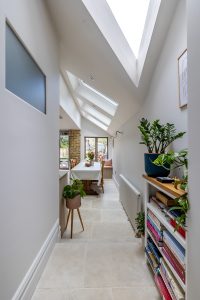
Glass extensions can look beautiful, however a key requirement is to always have clean windows. To avoid streaking, never try and clean the windows in direct sunlight. You can use soap and water or a commercial glass cleaner. However, the traditional mixture of one part white vinegar, four parts water, also works well.
How to clean large glass windows?
Always start at the top of each window and work your way down. Wet the glass with your chosen cleaner and gently rub any areas with stuck-on debris. Don’t do this too strongly if you have Low-E glass windows. Thoroughly rinse the windows using plenty of clean water. Remove as much water as possible using a clean cloth. Give the glass a polish with a microfibre towel to completely dry the window.
How to clean a glass roof?
If you have a glass roof, regularly clear away loose debris. Check guttering for dead leaves. Prepare a glass roof for cleaning by first gently removing loose debris such as leaves using a soft broom. Mix soap and water or a glass cleaning fluid with warm water in a bucket. Use the soft broom to gently scrub the roof. Rinse the roof with clean water. Finish by drying the glass with a microfibre towel – the glass will look as good as new.
Conclusion
Glass extensions are a great way to add a spacious extra room to your house to meet the changing needs of your family. Glass extensions with thermal efficiency give you extra space, all year round. The extension will prove cost-effective and keep at a pleasant temperature whatever the season.
Glass extensions are a home improvement that will increase the value of your property. Maximise on this and consult experienced professionals – who are highly-regarded by their customers. Build Team has more than 1,600 satisfied customers. Above all, its staff members are waiting for you to get in contact. Why not book a free design consultation today?


